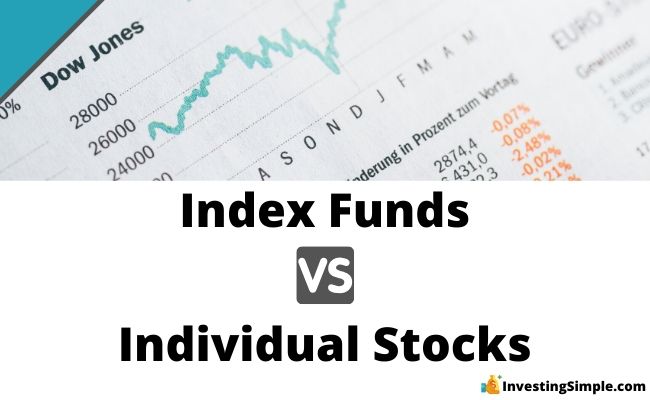





As investors, we have several types of investments at our disposal. But what we choose is often shaped by our beliefs about the world and ourselves.
One common decision for all stock market investors is the choice between purchasing individual stocks or investing in a group of stocks through index funds. The latter can take the shape of either index mutual funds or index ETFs. Index ETFs, for example, offer the flexibility of intraday trading and may have different tax efficiencies compared to mutual funds, which could be a significant factor for some investors.
Here are some factors to consider before making your decision about how to compose your portfolio. Whether it is focused on individual stocks, index funds, or some combination of both, adequate research is necessary in order to be absolutely certain.
Investors have many options when it comes to investing their hard-earned cash. As index funds rise in popularity, investors should understand the differences between individual stocks and index funds. Notably, passive index funds have grown significantly, now comprising a substantial portion of U.S. fund assets, highlighting their adoption advantage over active management.
While index funds provide increased diversification for investors, many investors are drawn to individual stocks as a result of increased upside potential. Over the long term, index fund investors consistently outperform individual stock investors. However, it's crucial to note that historical returns do not guarantee future results.
Most investors will have a strong opinion one way or the other, but it's important to come to this discussion with an open mind and understand the pros and cons of index funds vs. individual stocks.
Index funds offer investors exposure to all of the stocks contained in the index tracked by the index fund. Regardless of whether it is an index mutual fund or an index ETF, this allows investors to benefit from investing in a particular market. Often with a relatively small investment. Additionally, index funds typically have lower fees compared to actively managed funds, which can be a significant long-term advantage for investors.
When using index funds, it is relatively easy for an investor to build a well-diversified portfolio with just a few funds. For example, a three-fund portfolio might look like this:
For further diversification, investors might consider thematic index funds, such as those focusing on ESG (Environmental, Social, Governance) or technology sectors, which can align with personal values or market trends.
This is a relatively easy portfolio to build and maintain. For investors who want to include some additional asset classes to focus their portfolio in a specific direction, this can easily be done using index funds. This can likewise be the least expensive way to invest as index funds simply mirror the moves made by individual stocks and therefore, do not require human interaction.
As index funds become more accessible to everyday investors, there are a variety of platforms that offer investments in index funds. Here are some to name a few.
Betterment allows users to invest using pre-built portfolios of index funds. Investors will be offered portfolios constructed by Betterment's investment management team starting with a fee of 0.25% and no minimum investment. Betterment is a true robo-advisor, meaning that you can tell them a bit about yourself and your goals and let their system choose all the investments.
Read our full Betterment review to learn the ins and outs of the platform!
M1 Finance permits users to invest in ETFs or individual stocks. The M1 platform is more of a DIY option as you will pick your investments and add them to your custom portfolio. M1 Finance also offers pre-built portfolios constructed by their investment team. The minimum investment starts at $100 and there are $0 in fees.
Learn more about M1 Finance by reading our comprehensive M1 Finance review.
Many employers provide retirement plans for employees who meet certain requirements. If you qualify for your company's 401(k) plan, you can also invest in index funds through your plan provider. You can choose to spread out your investment across several index funds and there is often no minimum or restrictions on how often you can change your mind.
Investing in individual stocks involves purchasing shares of each company that you wish to invest in. For example, if you want all of your money to go to Apple, for instance, you would simply log into a brokerage account, search for Apple, and pour all of your cash into just one company.
With this transaction, there are usually fees involved like a transaction fee or commission fee with both buying and selling. However, most popular discount brokers and popular investing apps offer commission-free trades in order to attract and retain clients.
Generally, you will need to buy whole shares, though there are some apps that allow small investors to purchase fractional shares on their platform.
This investment strategy is the epitome of the adage: the higher the risk, the higher the potential reward. If you pick the right stock at the right time you can earn substantial profits. However, you could potentially lose it all if the company you invest in goes bankrupt. Recent market volatility has highlighted these risks, emphasizing the importance of thorough research and a solid investment strategy.
A hypothetical investor who invested in companies like Tesla or Amazon during their early growth phases would have seen significant returns. However, this is just an example of someone who struck it big. What is often less discussed are the many companies that do not experience such success, illustrating the high risk involved in individual stock investing.
When investing in individual stocks it's important to have a strong investment philosophy that you can stick with. Arguably the best investor of our time, Warren Buffett has shared his investing strategy and it's one that we all would do well to learn from.
Having a strong strategy and guiding principles will help you avoid making costly mistakes when choosing individual stocks to invest in.
Investing in individual stocks can provide you with more control over your taxes if you are using a taxable account. With individual stocks, you generally know the timing of any dividend payments during the year. Additionally, you are not subject to receiving taxable distributions from index funds for capital gains or dividends over which you have no control.
With individual shares, you decide when to sell the shares so you are in control of the timing of any capital gains or losses. This control can be advantageous for tax planning purposes, allowing you to decide whether your gains will be short-term or long-term, which can significantly impact your tax burden.
On the other hand, index funds may distribute capital gains to shareholders, which can increase your tax liability unexpectedly. This is an important consideration for investors who are tax-conscious.
Although the fees and expenses associated with index funds are relatively low compared with actively managed funds, there are still ongoing expenses. Individual stocks have none of these types of expenses. When you buy the stock, you own the stock, and there are no trailing fees that you'll have to pay while you own it.
Investing in individual stocks can have its disadvantages as well. With an index fund, you are investing in the pool of stocks that comprises the underlying index that the fund tracks. While the fund is not diversified in terms of the asset class it falls under, it is diversified in terms of holding a number of stocks. If one company in the index runs into financial difficulties and their share price drops, this might have some impact on the fund's performance. On the other hand, if you invest in an individual stock and the shares plummet in value you are fully exposed to the impact of this decline.
At the same time, you could build a portfolio of individual stocks in an effort to diversify your portfolio and reduce your overall risk. This will likely require you to have significantly more money to invest and more time in order to research each potential investment before deciding to take that risk.
One of the big advantages for index funds is that you can get exposure to hundreds of companies for under $100. Even with the ability to purchase fractional shares of individual stocks, it's difficult to build such a wide-ranging portfolio with little capital.
Being a successful investor in individual stocks takes research and an understanding of stock analysis. Do some soul searching to determine if you have the skills and the discipline needed to be an effective investor in individual stocks.
For starters, consider reading our guide on how to value a stock using fundamental analysis. This will provide an introductory framework for the factors that play into the value of an individual stock.
If you are looking for a stock analysis and research platform, Stock Rover provides an excellent resource. You can create stock screeners, build portfolios, and value a stock using specific metrics on the Stock Rover platform.
In the old days, you would need a stockbroker to place your trades for individual stocks. Nowadays with technology and the internet, trading using an online broker has become seamless. There are dozens of investing apps that allow beginner investors to get started. These are two of our favorite free options.
Webull lets users trade stocks, ETFs, and options for free. There are no trading fees and $0 account minimums to use Webull. Additionally, Webull offers new users a free stock when they sign up!
To get a better look at the Webull platform, read our full Webull Review!
With Robinhood users can trade stocks, ETFs, crypto, and options commission-free with no minimums. This is the most beginner-friendly stock trading app.
If you are interested in learning more, check out our full Robinhood review!
Both individual stocks and index funds have their relative advantages and disadvantages. In order to know which is the better option for you or any investor depends on your situation, goals, and the type of investor that you strive to be.
It is important to keep in mind, however, that this doesn't have to be an either/or decision. It can make sense to use both index funds and individual stocks as part of your investment portfolio.
If you have an IRA account, such as a Roth IRA, a taxable brokerage account, or both, it can make sense to use both index funds and individual stocks. The goal in all of this should be to build a diversified portfolio. For example, you might use several index funds to build the core of your portfolio. This can be done as easily as using an example like the three fund version illustrated above.
You can certainly add additional index funds focusing on different asset classes to round out your portfolio. Using this as your core ensures that you have a diversified base. From there you can branch out with individual stocks that interest you and that you feel can add depth to your portfolio.
Ultimately, building your investment portfolio is a culmination of many different decisions. Index funds vs. stocks is only one of many of those decisions. To ensure that your portfolio truly aligns with your goals and is going to be able to take you there, it's generally a good idea to chat with a CFP® or other financial professional.
| Feature | Index Funds | Individual Stocks |
|---|---|---|
| Risk | Lower risk due to diversification | Higher risk with potential for significant capital loss |
| Diversification | Automatically diversified across multiple stocks | Requires manual diversification |
| Fees | Generally lower fees compared to actively managed funds | No ongoing fees, but transaction costs may apply |
| Tax Efficiency | May distribute capital gains to shareholders | More control over taxable events |
| Required Knowledge | Less knowledge required due to simplicity | Requires significant research and analysis |
| Volatility | Less volatile due to diversification | Highly volatile with potential for rapid price changes |
Investing in individual stocks can also have psychological implications. The temptation to frequently trade individual stocks can lead to emotional decision-making, which might negatively impact returns. In contrast, passive index fund investing encourages discipline and a long-term perspective, which can be beneficial for investors trying to avoid making impulsive decisions based on short-term market fluctuations.
As of 2025, investors have access to a variety of platforms that support both index funds and individual stocks. Besides Betterment and M1 Finance, other robo-advisors with AI-driven portfolio management have emerged as modern options for investors seeking automated investment strategies.
Many financial experts emphasize the benefits of index funds for long-term investing. For instance, index funds have grown to comprise a significant portion of U.S. fund assets, reflecting their popularity and effectiveness in providing broad market exposure at lower costs.
To determine whether index funds or individual stocks are right for you, take a moment to evaluate your investment goals, risk tolerance, and time commitment:
Answering these questions will help you decide which investment strategy aligns best with your financial objectives and personal preferences.
Don't forget to grab your free stock worth up to $200 from Robinhood today!